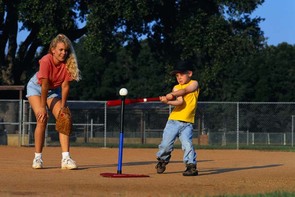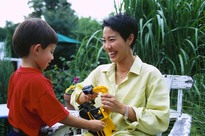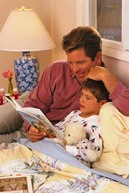 Many years ago, my 8 year old daughter was acting out and I sent her to her room. I don’t remember the details. Sometime later I was doing laundry in the basement. I had not processed Rachel’s time-out with her and she had not been let out of her room. Nonetheless, she made her way down to where I was doing laundry. Silently, she floated a paper airplane from the doorway to me, and then ran quickly back upstairs. There were markings on the plane, so I unfolded it. Rachel had written, “I hate you.” Wow! I was crestfallen, heartbroken, and stunned. I finished my load of laundry, giving me time to think about how to handle this. I went upstairs to her room. She was pretending to be asleep on her bed. I went to her side, placed the airplane on the bed and said, “You dropped this.” I started to leave her room, but Rachel bounded out of her bed, sobbing, and ran to hug me. “Daddy, I’m sorry. I didn’t mean it. I was mad. Please forgive me.” I folded her into my arms for a big hug and walked her back to her bed. We talked and worked it all out. Looking back, apparently, I had sent my little girl to her room without adequate active listening and context. She felt unheard and schemed to float her feelings to me on the paper airplane to get my attention. It worked! As we talked afterwards in her room, she recounted her perspective. I said, “I understand your anger, but what else were you feeling?” Anger is funny like that. About 98% of the time, anger is secondary to a more primary feeling. Because anger is the most socially accepted negative feeling we have, we use it to cover unheard, frustrated, embarrassed, guilty, worried, and a host of other feelings. Only about 2% of the time is anger the primary feeling. Another way to tag it would be “righteous indignation.” We’re mad because something is just not right. Think a young mother yelling at her toddler in the grocery story because he’s grabbing at things. Think any instance of child neglect, abuse, abandonment. Mostly, righteous indignation occurs when there is a power differential and the victim is helpless. So, I active listened, validating Rachel’s anger, but asking also, “what else are you feeling?” During the course of our talk, I saw her emotional fever going down. She then could accept my parenting perspective in correcting her behavior, and I helped her talk about ways she could avoid future such difficulties. For a relationship-building teachable moment with your child, acknowledge her anger, but then find the primary feelings behind the anger by asking, “What else is going on?”
0 Comments
 You remember vividly when each of your children were born. For moms, there is pain in childbirth. Don’t let anyone convince you that it’s just pressure J. However, this pain of childbirth is immediately thereafter replaced by the sheer joy of holding your newborn, nestling in your arms. For dads, I remember feeling awed, thrilled, and terrified. A definite OMG moment. When my baby looked up at me, I knew she was a keeper. What new parents don’t realize is that all babies, no matter what the circumstances, are born with an invisible sign hanging around their necks. I call it the IALAC sign, I-A-L-A-C, which is an acronym for “I am loved and cared for.” Each baby feels that love as they emerge from the womb. While lots of other emotions surround the birth, love is the predominant one. The IALAC sign remains, hidden but there, around our necks as we grow older. And yet, life events can chip away at our IALAC sign. Little 3 year old Julie got yelled at after accidentally knocking over her mom’s favorite lamp. It shattered on the ground. Ten year old Bobby didn’t get much playing time with his rec league basketball team. When he asked his coach, he was told that the team was winning and he wasn’t good enough to beat out the starters. Amanda, a 15 year old high school freshman, tearfully showed her failing history test score to her dad. He said abruptly, “Well, sweetheart, you should have studied harder.” At those moments, when this kind of stuff happens in our lives, a little piece of our IALAC sign gets torn away. Soon enough, the original sign can disappear all together. However, because we all must wear an IALAC sign throughout our lives, a new sign will appear. We were born with “I am loved and cared for.” Difficult events coupled with unkind words re-works our sign to now read “I am lonely and confused.” The kinds of caring, Christian parenting, communication tools I offer through my book and classes helps our children maintain their “I am loved and cared for” sign, even when our children make their way through the stress and strain of life. What message is your child getting from their IALAC sign?  Do you have a favorite childhood memory? I have three. As a small child, I would get up early on Saturday morning. My dad got up with me and made some breakfast. Then, magically, he would ask, “Wanna go for a walk?” That was a special dad time for talking, walking, and exploring. Also, we would usually find some wild flowers to bring back to my mom. I also remember spending two weeks at a summer YMCA camp as I got older. I think I was 7 when it began. Being a “big boy” on my own, meeting new friends, and learning new skills was all great. One time, after camp, my mom helped me unpack my trunk and discovered that none of the clothes I had brought home were mine. “Where are all your clothes, Jonny?” “Well, Mom, I traded them with the guys, you know…” She was put out and fussed at me, but at least my trades all fit me. Finally, summer vacations at the beach were super family fun. We all pitched in, planned stuff, and saved up so we could all have a great time. Usually, good times roll to the extent that you include your children in the planning and preparation for them. Ask your child if she wants to do the activity. If not, have a talk about options. If it is a family activity, include her in the planning and talk up the parts that would be fun for her. Get her input. Active listen her feelings. As your children get older, ages 8 and beyond, think about their inviting a friend to come along on the vacation. Two kids who get along great are usually easier to handle than one, because they tend to occupy each other. Good times roll because of good planning, including and delegating, and having something each family member is looking forward to. It’s summertime somewhere. Let the good times roll.  All kids get into stuff. Tots and teens? It doesn’t matter. They all mess up. How you handle these mess ups is what really matters. Turn a mess up into a teachable moment by using the Sandwich Effect. Because all kiss mess up, as parents, we can’t catch them being good enough. Every time your child does something right, obeys, shares, listens, organizes, sets up his own accountability system, and makes good lifestyle decisions, praise and reinforce his good choices. Teach them to use the What Would Jesus Do standard. However, stuff happens, and that needs your attention as well. When stuff becomes a learning experience for your daughter, she will become more accountable and grow wiser. So, praise and consequence. Conflicting concepts? Not in the least. Behold the Sandwich Effect. Fourteen year old Paul has a big social studies test tomorrow. It’s quiet upstairs and you anticipate Paul getting into his studies. You go to his bedroom door just to check on him and you see him with Ipod and ear buds, playing his air guitar and dancing around the room. Part of you wants to yell at him to get back to work, as you yank his Ipod from his hand. You take a deep breath and the wiser parent in you prevails. “Aww, man!” you start as you walk into his room. Paul gives you that oh crap, deer-in-the-headlights look. You continue, “Son, you were getting some serious studying in tonight. I just don’t think it’s a good idea to keep the Ipod cranked up and dance around your room if you plan to ace that test tomorrow. Turn off the music for just another twenty minutes, and I will come in to quiz you on what you’ve studied. Gosh, some day you’re gonna make me a rich man with your music, ya know.” Do you see what you just did? You started with a positive, serious studying, and followed with a negative, music distraction. You concluded with another, longer term, hopeful positive, benefits of his music. You sandwiched your negative between two positives. Start with a comment or affirmation, followed by constructive criticism, and conclude with more affirmation and encouragement. This is the formula for using the Sandwich Effect to create a teachable moment.  A favorite book of mine “back in the day” was titled, The Hurried Child. The notion was that our children have so much stress because they are always on the go. And I’m not just talking about hyperactive kids. With internet technology, all kinds of communication tools, plus encouraged activities such as recreational sports, scouting, church, and clubs, when can they take a breath? And, when can we catch up with them? Because of all the options on and pressure for their time and attention, we will want to grab every teachable moment we can with our kids, making the most of opportunities with them. Dad was taking son Joey to his Little League baseball practice one late Spring afternoon. Joey was eating his snack dinner in the car as they traveled there. “So, my man, excited about your game tomorrow night against the Pirates?” Between mouthfuls, Joey shrugged his shoulder and offered, “Whatever, yeah, I guess.” Noticing his son’s mood, Dad joked, “Well, now, don’t be so enthusiastic, big guy.” Again Joey shrugged, “It’s just that, I mean, Robbie’s pitching and I haven’t hit him yet all season.” In his best active listening form, Dad looked for a feeling. “So, you’re afraid he’ll get the best of you again?” “What do you think?” Joey conceded, with dejection in his voice. “I’ll tell you what I think, son, can I tell you?” “Whatever, yeah,” Joey mumbled from a full mouth. “I think that, what you pay attention to grows.” “Huh?” Joey questioned. “You know, focus on the positive and it will grow. Focus on the negative and it will grow.” “Well, I’m positive Robbie’s gonna get the best of me again.” “But you don’t know that, because it hasn’t happened yet, son. You can turn this around. Get your licks in with batting practice tonight and face Robbie in the batter’s box tomorrow night, just daring him to try and throw one by you. Focus on the positive and it will grow.” After taking his dad’s wise counsel in, Joey conceded, “Yeah. I’ll try it. We’ll see what happens.” Your teachable moments with your children do not have to be weekend camping trips, although don’t rule them out. Use a 5-minute car ride to connect. Make the most of all the available opportunities.  As we all know, kids come in all shapes and sizes. You know what else? So do parents. Some parents choose to be the power-oriented, in control kind of guy. These folks parent by fear and have only a fear-based relationship with their children. “My way or the highway” is their theme. Others go to the opposite extreme and become a doormat to their children. “Yes, dear. Whatever you want” They fear that confronting their child or setting healthy boundaries will stunt their emotional growth and lower their self-esteem. Such well-intentioned parents will put their child in T-Ball, where runs scored are not kept because “we want them all to be winners.” Fortunately, Jesus gave us another option, providing a third role model for effective parenting. Before the Last Supper, He removed his outer robe, got a bowl and washcloth, and washed the feet of his disciples. This lowly but loving act of service is our example of being a servant parent. What??? Let’s be clear. This was not submission. It was servanthood. Jesus followed with His teachings about the first being last and the greatest being the least. Being a servant parent involves understanding your child’s needs and feelings, and being supportive while helping tend to them. Fifteen year old Chip stomped into his dad’s den early one morning, where dad was paying bills. “Dad, this shirt’s dirty and I want to wear it today.” Dad stopped his work, and, while getting up, responded, “Okay, Son, let me wash it for you right away.” While thinking he was being helpful, dad was being a doormat, with no teachable moment in sight. Eight year old Tommy is doing his homework in his room. His mom checks on him and offers, “I’ve got some time, Son. If you put your vocabulary words on flash cards, I’ll quiz you when you’re finished.” Classic servant parenting. Being helpful and available, sharing the load. And ripe for a teachable moment. Which are you? Power dude, doormat or servant parent?  I’ve shared with you how active listening is your go-to response when your child has an emotional fever. This is the proverbial “You feel…” comment, where you give your child what you think she is feeling at the moment. However, to engage your daughter, dare to be different. That is, be creative in how you empathize. Also, to help her know how important her feelings are to you, expand your responses. Allison comes running in from outside, where she was talking to her friend, Jennifer. Allison slams the door and stomps into the kitchen, where you are cleaning up. “Jennifer says I’m dumb and she won’t play with me.” You gather her up in your arms and she sobs into your shoulder. An active listening response might be, “You feel hurt.” Daring to be different, you could expand that with, “Aw, baby, it hurts when Jennifer says mean things to you.” Allison will then hug you closer. Another tool in your response toolbox is called passive listening. Yep, you guessed it. This is simply being quiet and letting Allison just be or just talk. A verbal prompt that could help her share her feelings is called a noncommittal response. Us shrinks call this the therapeutic grunt, such as, “uh huh, hmmm, I see” This tells Allison that you are listening and encouraging her to share more. A third tool for you is parroting. This is when you say back as a question exactly what she just said. “Jennifer says you’re dumb and that she won’t play with you?” Here, you are making sure that you heard right and again prompting her to continue. The fourth tool is paraphrasing. Here you give her content, but not necessarily feelings. “So she’s not playing with you because she thinks your dumb?” Active listening is the gold standard for helping your child through tough times, but you can also expand your responses with parroting, noncommittal responses, paraphrasing, and just being quietly there with her, that is, passive listening. All of these options keep you engaged with your child in her hurt and let her know how important she is to you, helping her find her way out of her hurt. Expanding your responses helps you stay connected.  Four year old Matthew climbs up on their kitchen counter to retrieve the large box of dry kitty food. “Mommy,” he asks, “Can I feed the kitty?” Simple request. Our kids ask our permission almost all the time, and mostly we say yes. However, where parents are emotionally tuned in to their children, getting permission works both ways. Matthew’s mom has several choices. She could quickly reach over her son for the canister of dry kitty food and abruptly add, “Here, I’ll do that.” Or, she could caution, “Sweetheart, I think that’s too big for you to handle. Can I help?” Or, she could say, “Sure, Honey,” while gritting her teeth and preparing to pounce to avoid a mess. Taking over avoids the possible mess, but also deprives Matthew of a teachable moment. Mom’s unintended hidden message is, “Son, my keeping control and keeping my house orderly is more important than your curiosity and wanting to help me.” Ouch! Not good. Asking to help him is a step in the right direction, but her judgment that the canister is too big for him to handle deprives Matthew of an opportunity to experiment and to stretch his abilities. Telling him to go ahead, but expecting disaster, may set Matthew up for problems and feeling responsible for making the mess. This teachable moment in the making needs to start with mom giving observations and asking permission of her 4 year old son. “Matty, I’m glad you want to help kitty get to her food. You’re getting to be such a big boy. I know you don’t want to make a big mess and then have to clean it up. I have an idea. Can I share an it with you?” Getting permission from your child, at whatever age, often comes as a pleasant surprise to him. It also puts the focus on the relationship, not just the task. You share your wisdom and your child has an opportunity to grow, with your guidance. This is the value of getting permission.  “Why do I have to use behavior management, when I can just whip him and he’ll do what I want to avoid another whipping?” “Aren’t you just bribing your child to do good, with all that fancy psycho-babble?” Oh, the things I put up with as a practicing child psychologist. Don’t get me wrong. I know that you folks are well intentioned and that you have your child’s best interests at heart. Nonetheless, when you notice concerning behavior from your child, whipping it out of him may lead to compliance, but out of fear and at the cost of any meaningful, emotionally intimate relationship with that child. One form of behavior management is simply defining reward and consequence for your child. “Andy, play nice with your sister and you both get a treat. Be mean to her and you will spend the rest of the day in your room.” This may encourage compliance, and reinforces your absolute authority, but does not bring you closer together. When little Janey is involved in the process, then behavior management becomes a teachable moment, your authority is secure, and you are working on the “Good Kid” project together. In chapter 2 of my book, Teachable Moments: Building Blocks of Christian Parenting, where I answer the question, “Who’s In Charge,” I lay out use of The Good Kid Chart. This is your go-to for using behavior management as a teachable moment. First, you define the target behaviors in positive terms. “No hitting your sister” becomes “Play nicely together.” These target behaviors are tracked daily through the week, with both daily and weekly reward for your child showing the behavior. Reviewing her progress as a part of her bedtime routine encourages the joint effort. In addition to the Good Kid Chart, put together three, brightly decorated posters. With her help and participation, list daily rewards, weekly rewards, and consequences on one poster each. Be creative in what goes on each list. Encourage her involvement, but only include items that are within your time and expense restrictions. Once all is in place, try it for a week and see how it goes. As she succeeds at certain items, celebrate, and talk about what else she might work on. Remove and add items as she progresses. The beauty is that this is a fluid and continual chart that gives you opportunity to be an involved parent, work and grow together, and create teachable moments in your Christian parenting.  In life, at all ages, there is one, absolute and common rule. Do good and good things will happen. Do bad and bad things will happen. As parents, we want this to be our guiding principle for disciplining our children. Reward is the outcome when our children are doing good. Punishment is the consequence when they are doing bad. For some reason, most parents are more tuned in to the doing bad part of being a child. It takes effort to catch our children being good. Ten year old Nick has been re-writing his spelling words for 20 minutes now. After supper, he scooted to his room, turned off his electronics, and got down to homework without even being told to do so. His mom peeked in his doorway and smiled at him. He’s so cute when the tip of his tongue sneaks out the corner of his mouth as he is concentrating. Just then, Nick catches his mom watching him. “What??” and he frowns, “Leave me alone.” “Careful, son. Watch your tone,” mom scolds. Nick frowns, throws his pencil down, and stomps past his mom in silence to use the bathroom. Mom just blew a perfect opportunity to catch Nick being good. In such circumstances, I encourage parents to use what is called “The Sandwich Effect.” When you find a need to correct your child’s behavior or attitude, put the caution between two praise comments, like two slices of bread with meat in between. As Nick breezed by her, mom could have said, “Aww. You are knocking out those spelling words. I bet you do great on the test tomorrow.” That’s a praise comment. Follow it with a caution, “Not sure how the attitude fits in here. I didn’t mean to break your concentration.” And finish with another praise comment, “I’m so proud of you for tackling these spelling words on your own. Let me know if you want me to quiz you later.” The two praise comments for every caution or correction is a good ratio to follow. Over time, you get tuned in to catching your child being good, and your child receives the criticism without making matters worse. Kids always test the limits and, by nature, can wear us out. In Ephesians 6, the apostle Paul cautions children to obey their parents, as the right thing to do, and parents to not provoke their anger, but bring them up in the ways of the Lord. The best way to do that is to catch them being good |
Archives
January 2024
Categories
All
|

 RSS Feed
RSS Feed
